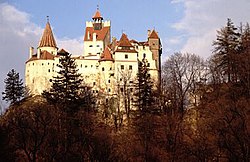Bran Castle





Bran Castle (‹See Tfd›German: Törzburg; Hungarian: Törcsvár), situated near Bran and in the immediate vicinity of Braşov, is a national monument and landmark in Romania. The fortress is situated on the border between Transylvania and Wallachia, on Highway 73. Commonly known as "Dracula's Castle" (Although the real Dracula's castle is in ruins), it is marketed as the home of the titular character in Bram Stoker's Dracula. There is, however, no evidence that Stoker knew anything about this castle. Furthermore, there are persistent myths that it was once the home of Vlad Ţepeş, ruler of Wallachia. This is not true. The historical person Vlad III never resided here.
The castle is now a museum open to tourists, displaying art and furniture collected by Queen Marie. Tourists can see the interior individually or by a guided tour. At the bottom of the hill is a small open air museum park exhibiting traditional Romanian peasant structures (cottages, barns, etc.) from across the country.
History
In 1212 the Teutonic Knights built the wooden castle of Dietrichstein as a fortified position in the Burzenland at the entrance to a mountain valley through which traders had travelled for more than a millennium, although it was destroyed in 1242 by the Mongols. The first documented mentioning of Bran Castle is the act issued by Louis I of Hungary on November 19, 1377, giving the Saxons of Kronstadt (Braşov) the privilege to build the stone citadel; the settlement of Bran began to develop nearby. The castle was first used in 1378 in defence against the Ottoman Empire, and later became a customs post on the mountain pass between Transylvania and Wallachia. The castle briefly belonged to Mircea the Elder of Wallachia. While Vlad Ţepeş did not actually live in the Bran Castle, it is believed he spent two days locked in the dungeon while the Ottomans controlled Transylvania.[citation needed]
From 1920 the castle became a royal residence within the Kingdom of Romania. It was the principal home of Queen Marie, and is decorated largely with artefacts from her time, including traditional furniture and tapestries that she collected to highlight Romanian crafts and skills.- It was inherited by her daughter, Princess Ileana, and was later seized by the communist regime after the expulsion of the royal family in 1948.
In 2005, the Romanian government passed a special law allowing restitution claims on properties such as Bran, which was seized by the Communist government of Romania in 1948. In 2006, the Romanian government awarded ownership to Archduke Dominic of Austria, Prince of Tuscany, known as Dominic von Habsburg, an architect in New York State and the son and heir of Princess Ileana.[1][2]
In 2007, von Habsburg put the castle up for sale for a price of £40 million ($78 million).[3] On July 2, 2007, Michael Gardner, Chairman and Chief Executive Officer of Baytree Capital, the New York investment firm which has been retained to create a plan for the castle and to sell it, predicted it would sell for more than $135 million, but added that von Habsburg will only sell it to a buyer "who will treat the property and its history with appropriate respect."[4]
In September 2007 an investigation committee of the Romanian Parliament stated that the retrocession of the castle to von Habsburg was illegal, as it broke the Romanian law on property and succession.[5] However, in October 2007 the Constitutional Court of Romania rejected the parliament's petition on the matter. In addition, an investigation commission of the Romanian government issued a decision in December 2007 reaffirming the validity and legality of the restitution procedures used and confirming that the restitution was made in full compliance with the law.[6][7][8][9]
On January 26 2009 it was revealed that the family had decided not to sell the castle, but instead turn it into a museum dedicated to the legend and history of Dracula.
See also
References
- ^ Son stakes Dracula castle claim, BBC News, May 26, 2006 (accessed on January 9, 2007)
- ^ "N.Y. heir to get Dracula's digs", New York Daily News, May 24, 2006 (accessed on January 9, 2007)
- ^ "Vlad the unique selling point", The Daily Telegraph, January 6, 2007
- ^ Alexandru Alexe, "Heir puts 'Dracula's Castle' for sale", Associated Press, July 2, 2007.
- ^ Camera Deputatilor: Castelul Bran a fost retrocedat ilegal - Realitatea TV - Politică
- ^ Adevarul
- ^ Mediafax
- ^ http://www.ccr.ro/CCRDocFiles/Dosar%201369_2007.doc
- ^ Poziţia MCC faţă de Raportul Subcomisiei de anchetă parlamentară privind cercetarea legalităţii retrocedării Castelului Bran şi a procedurii de scoatere la vânzare a acestuia
External links
- Bran Castle Museum official website
- Dracula's Castle - The site that started it all, back in 1997
- Pictures inside the castle
- Pictures of Bran Castle and the Bran Castle Museum
- Detailed instructions about how to get to Bran Castle — with estimated local travel costs
- Legend and the facts surrounding Romania's most famous castle
- Castelul Bran — picture gallery, related books, and articles
- Michael Gardner's biography on Baytree Capital's website
- Bran Castle - 360 Virtual Tour Travel destinations
- How to get to Bran Castle – house of Dracula
- Bran Castle and other Dracula-related places in Romania - with images, floor plans and much more
